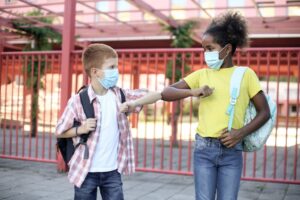COVID-19 on Campus: Trends, Tactics, and Tips to Stay Safe
Just when you thought it was safe to go back into the water . . . or back to campus, rather.
Unfortunately, it looks like we'll be taking COVID-19 back to school with us again this year, along with freshly-sharpened number-two pencils and brand new composition books.
The good news is we know a lot more about the novel coronavirus than we did a year ago—plus the vaccines should make hitting the books (in person) safer and easier to navigate.
Whether you're heading back to a college campus or sending youngsters off to elementary and secondary (K–12) classrooms, here are some tips to help you get back to school safely and sanely.
Get updates on the latest safety news, product releases, and deals.
By signing up, you agree to our Terms and Conditions and Privacy Policy.
Get the latest about COVID-19 campus safety

Find out in our Safest College Towns report. We ranked college towns across the US based on which ones report the fewest crimes, and we highlighted COVID-19 plans for the fall semester. (Watch for our 2021 update, coming soon!)
Coronavirus on college campuses
It looks like America's colleges are going to be open for business on campus with full slates of in-person classes replacing the online and hybrid openings we saw last fall.
But things won't look the same on every campus. Due to conflicting advice about masks and controversy over vaccine mandates, requirements for returning to campus vary widely from school to school.
Here's a rundown of what's happening at some of the nation's biggest colleges, and how to find out what your university requires.
College COVID-19 trends:
- A federal appeals court upheld an Indiana University's COVID-19 vaccine requirement for all students, staff, and faculty.
- Both Ivies and state colleges are rolling out face mask requirements for in-person classes and large outdoor gatherings on campus. Among the schools asking students to mask up are Duke, Purdue University, Yale, University of Missouri, Cornell, Lincoln University (Missouri), and the entire California and New York State University systems.
- If you go to university in Hawaii and don't want to get the vaccine, you can undergo weekly COVID-19 testing instead.
- Instead of vaccine mandates, Auburn University in Alabama (where only 34% of residents are fully vaccinated) is offering prizes for students who opt to get the jab.
- Despite citywide mask mandates, colleges in Georgia aren't requiring students to mask up on campus.
- A statewide executive order in Arizona bans colleges from requiring face masks, COVID-19 vaccines, and regular COVID testing.
How to find out about mask and vaccine requirements at your college
While there isn't a national database that tracks mask mandates and COVID-19 vaccine requirements for every college in the US, there are some resources you can use.
BestColleges.com has the most comprehensive list of colleges that require a vaccine for in-person attendance. The site regularly updates the list as new college requirements are announced, so check back if you don't see your school.
We haven't been able to find a countrywide list of colleges requiring masks indoors—for both vaccinated and unvaccinated students—but you should be able to find out on your college's website. If the information isn't clear or easy to find, give the university a call before you're scheduled to show up on campus.
The Centers for Disease Control and Prevention (CDC) recommend that all colleges encourage vaccination and use its guidelines to determine other preventative measures like mask mandates.
Coronavirus in K–12 schools
If it seems like colleges and universities have it tough, it gets even trickier for K–12 schools to respond to the ever-changing COVID-19 guidance.
There isn’t a cohesive national approach for states and school districts to follow, so schools end up being pulled between the ultimate goal of keeping students, staff, and faculty safe and meeting demands from teachers unions, parents, and their local and state governments.
And it doesn't help that many of the students in K–12 schools aren't able to get vaccinated yet. But it's not all bad news. Find our tips and insights for making the most of back to school as the battle against COVID-19 rages on.
Good news for K–12 classrooms despite COVID-19
- In-person school is back in session. While some school districts are still offering fully online or hybrid options, every school district in the US plans to have students on campus and in class this fall.
- Physical distancing guidelines for schools remain at three feet—half of what was required at the start of school last fall.
- Vaccinations may make life easier, especially in high schools. While 40% of eligible 16- to 17-year-olds are fully vaccinated, that number jumps to 70% for Northern states, according to a report by CNN.
What K–12 schools are doing about COVID-19
- According to CNN, 42% of the country's largest school districts are requiring masks for all individuals, regardless of vaccination status.
- Many schools are struggling to put a plan in place for students, faculty, and staff who test positive for COVID-19. Mandatory quarantines, like those we saw last year, may no longer be in place.
- There are at least 13 states that have passed laws that make it nearly impossible for schools to ask for proof of COVID-19 vaccination: Alabama, Arkansas, Florida, Indiana, Iowa, Kansas, Missouri, Montana, North Dakota, Tennessee, Texas, and Utah.
Current CDC guidance recommends COVID-19 vaccines for everyone 12 years and older. Read the full recommendation to find out about benefits, side effects, availability, and how to prepare for a vaccination with your child.
Tips to stay safe on campus
- Know the plan. Stay up-to-date on your school’s COVID-19 plans and policies. If possible, set up email or other alerts to make sure you don’t miss any changes to how your school is addressing the pandemic.
- Bring a backup. If you’re a college, middle school, or high school student where masks are required, pack a spare mask or face covering in case you sneeze or otherwise dirty the one you’re wearing. For elementary students, tuck an extra mask into their backpack or lunchbox. Put the spare in a reusable baggie, and drop in the used mask when you swap them out.
- Sanitize. Washing with soap and water is still recommended as the most effective way to destroy the virus on our hands, but you can’t always find a sink when you need one. Pack a “COVID-19 kit” with hand sanitizer and disinfecting wipes. (This is a great place to stash that spare mask, too.)
- Keep your distance. Whether it’s the lunchline or the restroom queue, make sure you practice social distancing. Maintain at least three feet between you and other students. If you have to be closer, keep your mask on for extra protection.
Get more tips for campus safety during the COVID-19 pandemic in our guide to staying safe at college.
Tips to stay safe during online learning
- Stay up-to-date. Make sure that operating systems, apps, and antivirus software are updated on your laptop, tablet, or other device that’s used for online classes. Updates provide the latest fixes and patches for security vulnerabilities and new computer viruses.
- Keep things private. Limit the information you or your children share in online classes or other forums. Keep things like full birthdates, social security numbers, and other identifying information off-limits.
- Mind the camera. If you’re taking online classes at home, there’s more than your face on display. Make sure that whatever’s happening in your background is appropriate for the classroom environment—and don’t display things like to-do lists or the family calendar. Those bits of info can be a goldmine for online predators.
Learn more about protecting yourself online in our computer safety guide and check out our video chat safety checklist for younger students. We've also got some helpful videos that show you how to ensure privacy during online classes.
Recent Articles




The post COVID-19 on Campus: Trends, Tactics, and Tips to Stay Safe appeared first on SafeWise.
Article source here: COVID-19 on Campus: Trends, Tactics, and Tips to Stay Safe
